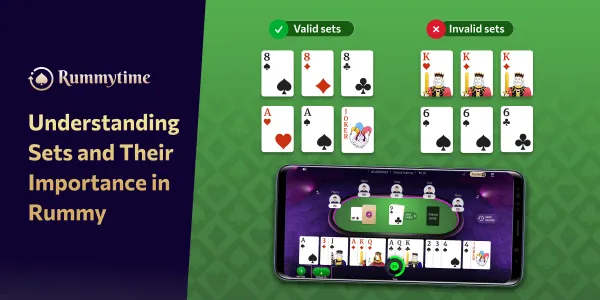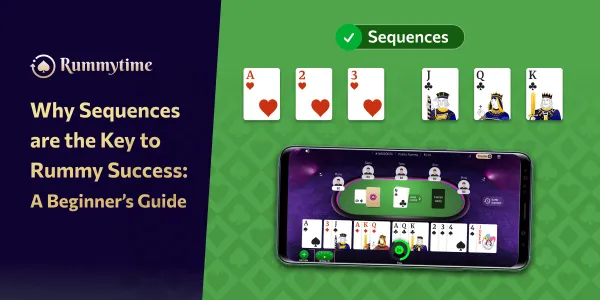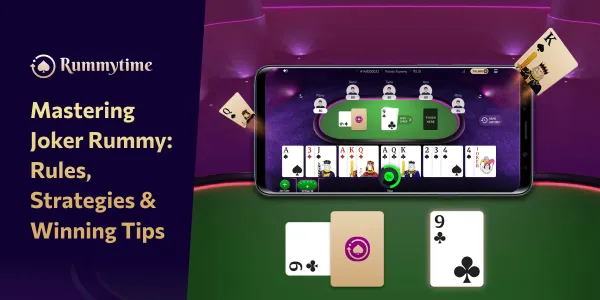- Home
- Rummy Rules
Rummy Rules - Learn How to Play Rummy
Rummy game rules are simple yet strategic, making rummy one of the most widely enjoyed games in India. Every day, crores of Indians play the game either online or offline. In fact, rummy’s popularity is one of the reasons why apps like RummyTime are so beloved by so many across the country.
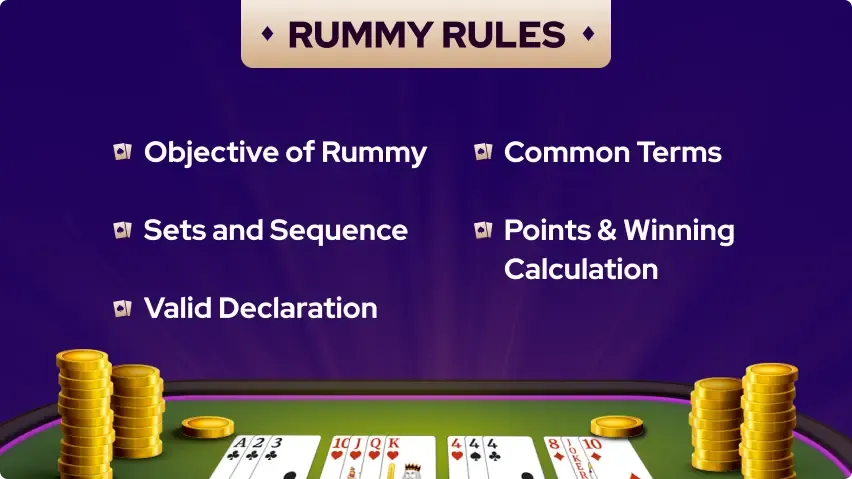
Now, the basics of playing a 13-card rummy are the same whether you play it with friends at a party or on RummyTime. The game involves each player receiving 13 cards, and typically, 2 decks of cards are used. In the course of the game, participants draw and discard cards strategically to form sequences and sets.
Understanding rummy rules is essential for mastering the game. Scoring in a rummy game depends on the value of the cards that are ungrouped. The value of all the cards are as follows:
- Printed joker/wild card joker: 0 points
- Face cards (K, Q and J): 10 points
- Ace cards: 10 points
- Numerical cards: Their value corresponds to the number printed on the card. So, a 2 of hearts will carry 2 points.
The Objective of the Indian Rummy Game
The objective of the game is to follow the rummy rules and be the first person to make a valid declaration. This happens when a player sorts their cards into groups or sequences until all the cards are grouped (a valid declaration can only happen when they have at least 2 sequences with one of them being a pure sequence).
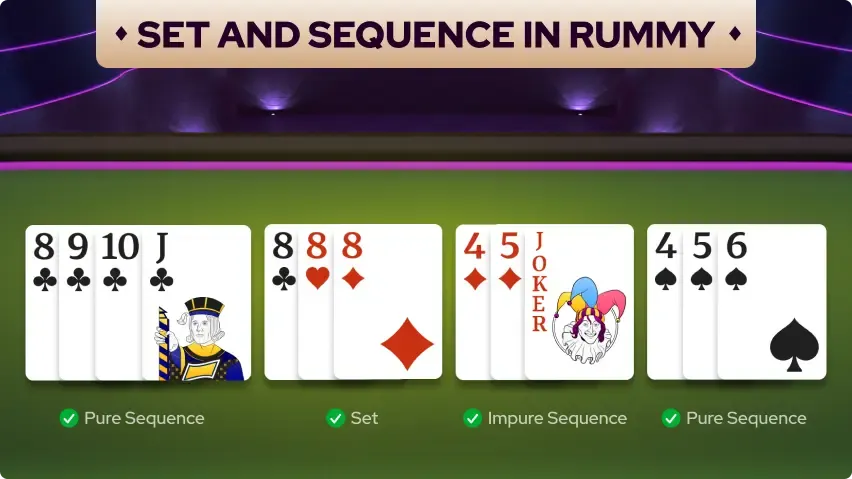
Understanding Rummy Rules for Sequences
A sequence is also called a run. As per the rummy game rules, at least 3 or more sequential cards of the same suit, then they become a sequence. There are two types of sequences:
Pure Sequence
This grouping features three or more consecutive cards that are all part of the same suit. A wildcard joker can be used to create a pure sequence if it naturally fits into the pure sequence. For example, if you have 7 and 9 of spades, and 8 is wildcard joker, then you can still use 8 of spades to form a pure sequence.
Here’s an example of a pure sequence:
Impure Sequence
This grouping will have a joker/wildcard that will complete the sequence.
Here’s an example of an impure sequence with a printed joker:
Here’s an example of an impure sequence with a wild card joker (here 2♠ acts as the wild card joker):
Rummy Game Rules: Understanding Sets
In rummy game rules, A set consists of cards of the same value but belonging to different suits when grouped together become a set.
Example:
when clubbed together become a set.
Here’s what you should keep in mind:
- There need to be at least three cards for it to be considered a valid set.
- They should all be from different suits. If a set has two cards of the same value and from the same suit, then they will be considered invalid.
- A set can be no more than 4 cards even including the joker (of different suits).
- A valid declaration does not need to include a set as long as the declaration has valid sequences throughout.
- A set can be completed with a joker/jokers (wild card jokers as well).
Following are few more examples of Sets:
- 7♥7♦7♣
- 5♥5♦5♠5♣
- A♦A♠A♣
As stated earlier, if a set has two cards of the same value and from the same suit, then they will be considered invalid.
Here’s an example of an invalid set:
Understanding these rummy rules will help you play more efficiently and make strategic moves while forming sets and sequences.
How to Play Rummy
There are between two and six players in each game. When it comes to most popular variants like Points rummy, everyone in the game is dealt at least 13 cards each. There are two decks used in general.
At the start of each game, one card (randomly selected) is chosen as a wildcard. This card will function the same way as a printed joker card. For example, if six of hearts is chosen as a wildcard, then six of spades, six of hearts, six of clubs, and six of diamonds will all be considered wildcard jokers in the game.
There is a draw pile (closed deck) and a discard pile (open deck). With every turn, players draw one card from the closed deck or the open deck and discard one card to the open deck. Based on what cards they get, they arrange their cards into sets and sequences. This is called melding.
If you want to step up your game and have a better chance of winning, learning these rummy rules is the way to go. The different rummy games have the same core rummy game rules, learning those rules is the first stage to excel as a rummy player.
Pro Rummy Tips to Outsmart Your Opponents
Mastering rummy game rules is essential to improving your gameplay. Following are the few rummy tips and tricks often incorporated by pro players to outsmart their opponents:
- According to rummy rules, the most important thing to remember while grouping your cards is to form pure sequences first. The second priority should be to form another sequence, pure or impure.
- Try and discard ungrouped high-value cards. In case someone else makes a valid declaration, you won’t be burdened with a high-value card.
- As per rummy game rules, joker (printed or wild card) smartly. Use them to form groupings with high-value cards.
- Know when to drop from a game.
Terms Used in Indian Rummy
Understanding Rummy Game Rules for Gaining Experts in It. Knowing the right rummy rules will help you to make strategic moves in the game, whether you are a beginner or a pro player
Table - A table is basically the virtual or the real space where the game is played. Here, you will see the open pile, the closed pile, and the wild card joker. Gameplay happens at the table.
Printed joker and wild card joker - A joker is one of the most sought-after cards in a game of rummy. It can be used as a replacement for a missing card or cards in a sequence or a set. There are generally four printed jokers in a rummy game played with two decks of cards. Additionally, a card is randomly drawn at the start of every game and is declared a wild card joker. All cards from different suits that have the same value can be used as wild card jokers during the game. If a printed joker is drawn, then all aces will be considered wild card jokers.
Draw and discard - As per standard rummy rules, during their turn, all players have to draw a card from the open/closed pile and discard one card to the open pile.
Card sorting - All cards are thoroughly shuffled before the start of a game. And, then they are dealt to the players.
Drop - As stated earlier, players have the option to drop out of games in most rummy game rules, when they play on a rummy app. Depending on when they drop out, they will be penalised accordingly. Do note that this option is not available for Deals rummy (2-player, 1 deal variants).
Invalid Declaration - An invalid declaration happens when a player makes a declaration but has not sorted their cards correctly. They will be penalised for this according to rummy rules.
Declaration With an Invalid Set
Here, an invalid declaration happens because of incorrectly grouping a set. Here are a few examples:
Example 1
(pure sequence)
(impure sequence)
(invalid set)
Example 2
(pure sequence)
(impure sequence)
(invalid set)
Example 3
(invalid set)
(pure sequence)
(pure sequence)
Declaration with Invalid Sequence
Here, an invalid declaration happens because of incorrectly creating a sequence. Here are a few examples:
Example 1
(incorrect sequence)
(impure sequence)
(set)
Example 2
(pure sequence)
(incorrect impure sequence)
(set)
Example 3
(set)
(incorrect pure sequence)
(pure sequence)
Valid Declaration in 13 Card Rummy - Possible Combinations
Understanding rummy game rules is essential for making a valid declaration. There is nothing sweeter in a 13 card rummy game than a valid declaration. Because that means the player who declared first is the winner (and hopefully it’s you!).
Here’s what you should know about valid declarations:
- A valid declaration should have at least TWO sequences. Of these two sequences, one of them has to be a pure sequence.
- There are no limitations on the number of sets as long as there are two sequences (with one of them being a pure sequence).
- All the cards can be in sequences. There is no need to have at least one set for it to be a valid declaration.
Once you meet the requirements of a valid declaration, you can discard the 14th card and declare. Here are some permutations of a valid declaration.
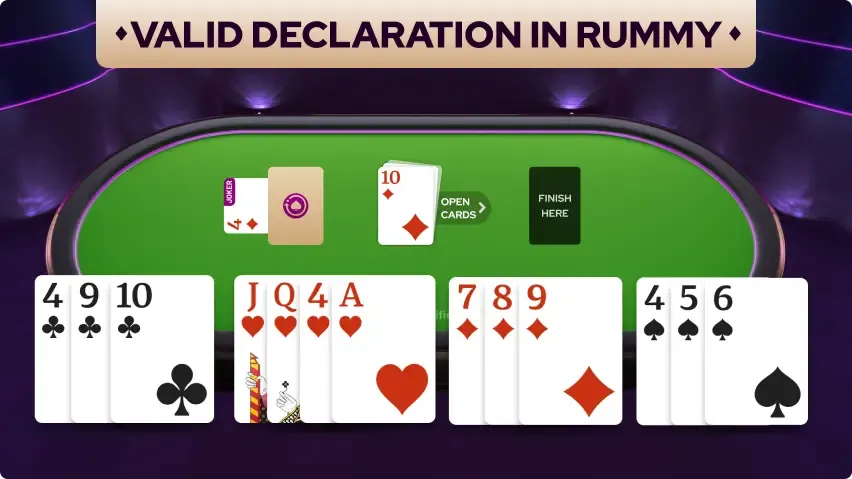
| Pure Sequence | Impure Sequence | Sets |
|---|---|---|
Every game must have at least 1 pure sequence. | All games must have 2 sequences. However, it is not compulsory to have an impure sequence. | Grouping cards into sets is really helpful but it is not a requisite as long as you have two sequences and all your cards are grouped. |
Cards must be in a sequential order. And, they should be of the same suit. | Cards should be in sequential order and should be of the same suit. | They should be the same numerical values from different suits. |
You need at least 3 cards to make a pure sequence. | You need at least 3 cards to make an impure sequence. | You need at least 3 cards to make a set. |
You can use a wild card joker to create a pure sequence, like mentioned in the example above. | You can use a joker to use in place of a missing card. | You can use a joker to complete a set. |
Calculation of Points in Indian Rummy
Here’s how penalty points are calculated for the losing player and the winner:
Let’s imagine someone is playing a 2-player version of Points rummy in RummyTime. Their opponent has made a valid declaration. Here’s how the points will be calculated for the losing player.
| Player | Cards | Points |
|---|---|---|
| Player 1 (winner) | 2♠ 3♠ 4♠ 5♠ 6♠ (sequence) 7♣ 8♣ wild card joker 10♣ (impure sequence) K♦ K♥ K♠ K♣ ( set) | 0 |
| Player 2 | 2 ♣ 3♣ 4♣ 5♣ 6♣ (pure sequence) 7♥ 8♥ 9♥ 10♥ (pure sequence) 10♥ 10♦ 9♣ J♣ (ungrouped cards) | Pure sequence = 0 Pure sequence = 0 Ungrouped cards: 10+10+9+10= 39 |
In this game, the losing player lost by 39 points.
Calculations of Winning Amount in Real Cash Rummy
For the different rummy variants that are available on RummyTime, the winning amount in cash rummy games is calculated in the following ways:
Calculations of the Winning Amount in Points Rummy
In Points Rummy, the winning amount is calculated as follows:
Winning amount = Sum of the points of all the losing players X Value of each point in rupees - RummyTime’s commission.
Consider a scenario with six players playing a Points rummy game with a Buy-In set at ₹360, and a predefined value of ₹5 per point.
Suppose Player 5 wins the game, while Players 1, 2, 3, 4, and 6 lose the hand by 25, 35, 50, 20, and 45 points, respectively. The winnings would be computed as 5 X (25 + 35 + 50 + 20 + 45) = ₹875.
After deducting RummyTime’s commission, the net amount will be credited to Player 5's account.
Calculations of the Winning Amount in Deals Rummy
In Deals Rummy, the winning amount is calculated as follows:
Winning amount = Buy-In X Number of players - RummyTime’s commission.
Consider a 6-player, 3-deals game starting with 240 chips per player. Here's the outcome after the first deal:
- Player A: 0 points (winner)
- Player B: 42 chips
- Player C: 29 chips
- Player D: 23 chips
- Player E: 17 chips
- Player F: 19 chips
The winning player receives (42 + 29 + 23 + 17+ 19) chips added to their starting amount. And, here are the number of chips they will have at the start of the second deal: 240 + 130 = 370.
The other players have chips deducted equal to their points from their balance:
- Player B: 198 chips
- Player C: 211 chips
- Player D: 217 chips
- Player E: 223 chips
- Player F: 221 chips
Similar calculations will occur at the end of the 2nd and 3rd deals and the player with the most chips after all the deals will be declared the overall winner.
Calculations of the Winning Amount in Pool Rummy
In Pool Rummy, the winning amount is calculated as follows:
Winning amount = Buy-In X Number of players - RummyTime’s commission
Consider a scenario with six players playing a game of 61 Pool rummy. Buy-In set at ₹100. Suppose Player 2 wins the game, while Players 1, 3, 4, 5, and 6 lose.
The winnings would be computed as 6 X (100) = ₹600. After deducting RummyTime’s commission, the net amount will be credited to Player 2's account.
So, that’s it. These are the main rules you have to keep in mind while playing 13-card rummy in RummyTime. Make sure you download the app and get started!
Related articles
Review RummyTime app

Loved playing rummy on RummyTime? Share your valuable feedback.

